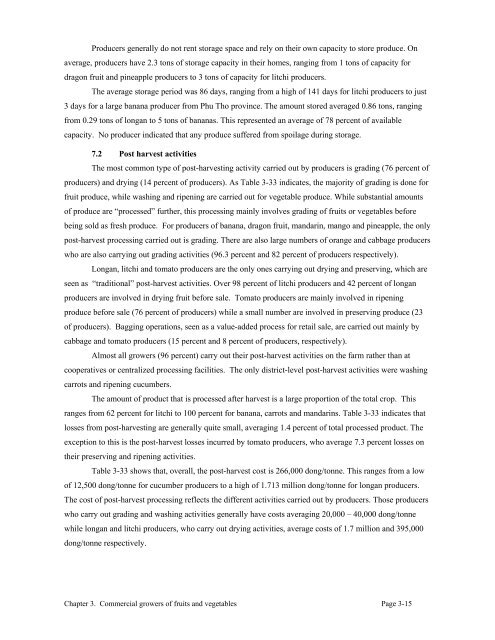Fruits and Vegetables in Vietnam - International Food Policy ...
Fruits and Vegetables in Vietnam - International Food Policy ...
Fruits and Vegetables in Vietnam - International Food Policy ...
Create successful ePaper yourself
Turn your PDF publications into a flip-book with our unique Google optimized e-Paper software.
Producers generally do not rent storage space <strong>and</strong> rely on their own capacity to store produce. On<br />
average, producers have 2.3 tons of storage capacity <strong>in</strong> their homes, rang<strong>in</strong>g from 1 tons of capacity for<br />
dragon fruit <strong>and</strong> p<strong>in</strong>eapple producers to 3 tons of capacity for litchi producers.<br />
The average storage period was 86 days, rang<strong>in</strong>g from a high of 141 days for litchi producers to just<br />
3 days for a large banana producer from Phu Tho prov<strong>in</strong>ce. The amount stored averaged 0.86 tons, rang<strong>in</strong>g<br />
from 0.29 tons of longan to 5 tons of bananas. This represented an average of 78 percent of available<br />
capacity. No producer <strong>in</strong>dicated that any produce suffered from spoilage dur<strong>in</strong>g storage.<br />
7.2 Post harvest activities<br />
The most common type of post-harvest<strong>in</strong>g activity carried out by producers is grad<strong>in</strong>g (76 percent of<br />
producers) <strong>and</strong> dry<strong>in</strong>g (14 percent of producers). As Table 3-33 <strong>in</strong>dicates, the majority of grad<strong>in</strong>g is done for<br />
fruit produce, while wash<strong>in</strong>g <strong>and</strong> ripen<strong>in</strong>g are carried out for vegetable produce. While substantial amounts<br />
of produce are “processed” further, this process<strong>in</strong>g ma<strong>in</strong>ly <strong>in</strong>volves grad<strong>in</strong>g of fruits or vegetables before<br />
be<strong>in</strong>g sold as fresh produce. For producers of banana, dragon fruit, m<strong>and</strong>ar<strong>in</strong>, mango <strong>and</strong> p<strong>in</strong>eapple, the only<br />
post-harvest process<strong>in</strong>g carried out is grad<strong>in</strong>g. There are also large numbers of orange <strong>and</strong> cabbage producers<br />
who are also carry<strong>in</strong>g out grad<strong>in</strong>g activities (96.3 percent <strong>and</strong> 82 percent of producers respectively).<br />
Longan, litchi <strong>and</strong> tomato producers are the only ones carry<strong>in</strong>g out dry<strong>in</strong>g <strong>and</strong> preserv<strong>in</strong>g, which are<br />
seen as “traditional” post-harvest activities. Over 98 percent of litchi producers <strong>and</strong> 42 percent of longan<br />
producers are <strong>in</strong>volved <strong>in</strong> dry<strong>in</strong>g fruit before sale. Tomato producers are ma<strong>in</strong>ly <strong>in</strong>volved <strong>in</strong> ripen<strong>in</strong>g<br />
produce before sale (76 percent of producers) while a small number are <strong>in</strong>volved <strong>in</strong> preserv<strong>in</strong>g produce (23<br />
of producers). Bagg<strong>in</strong>g operations, seen as a value-added process for retail sale, are carried out ma<strong>in</strong>ly by<br />
cabbage <strong>and</strong> tomato producers (15 percent <strong>and</strong> 8 percent of producers, respectively).<br />
Almost all growers (96 percent) carry out their post-harvest activities on the farm rather than at<br />
cooperatives or centralized process<strong>in</strong>g facilities. The only district-level post-harvest activities were wash<strong>in</strong>g<br />
carrots <strong>and</strong> ripen<strong>in</strong>g cucumbers.<br />
The amount of product that is processed after harvest is a large proportion of the total crop. This<br />
ranges from 62 percent for litchi to 100 percent for banana, carrots <strong>and</strong> m<strong>and</strong>ar<strong>in</strong>s. Table 3-33 <strong>in</strong>dicates that<br />
losses from post-harvest<strong>in</strong>g are generally quite small, averag<strong>in</strong>g 1.4 percent of total processed product. The<br />
exception to this is the post-harvest losses <strong>in</strong>curred by tomato producers, who average 7.3 percent losses on<br />
their preserv<strong>in</strong>g <strong>and</strong> ripen<strong>in</strong>g activities.<br />
Table 3-33 shows that, overall, the post-harvest cost is 266,000 dong/tonne. This ranges from a low<br />
of 12,500 dong/tonne for cucumber producers to a high of 1.713 million dong/tonne for longan producers.<br />
The cost of post-harvest process<strong>in</strong>g reflects the different activities carried out by producers. Those producers<br />
who carry out grad<strong>in</strong>g <strong>and</strong> wash<strong>in</strong>g activities generally have costs averag<strong>in</strong>g 20,000 – 40,000 dong/tonne<br />
while longan <strong>and</strong> litchi producers, who carry out dry<strong>in</strong>g activities, average costs of 1.7 million <strong>and</strong> 395,000<br />
dong/tonne respectively.<br />
Chapter 3. Commercial growers of fruits <strong>and</strong> vegetables Page 3-15
















